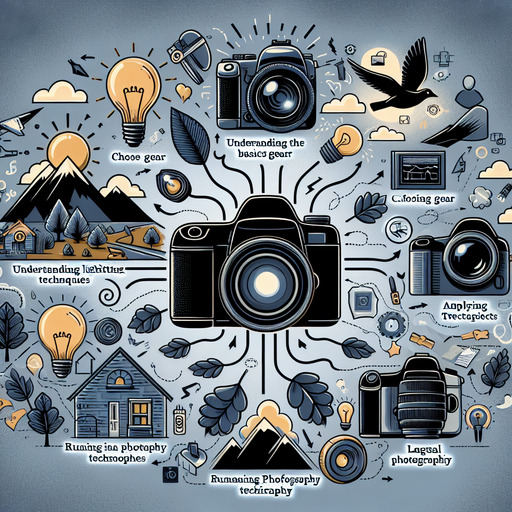
-
Table of Contents
- Mastering Photography: Essential Tips and Techniques for Every Photographer
- Understanding the Basics of Photography
- Photography Gear: Choosing the Right Equipment
- Photography Lighting: Mastering Light for Perfect Shots
- Advanced Photography Techniques
- Portrait Photography: Capturing Emotions and Expressions
- Landscape Photography: Embracing Nature’s Beauty
- Editing and Post-Processing
- Photography Editing: Enhancing Your Images
- Building a Photography Business
- Photography Services: Offering Professional Solutions
- Conclusion
- Questions and Answers
Mastering Photography: Essential Tips and Techniques for Every Photographer
Photography is more than just capturing moments; it’s about telling stories, evoking emotions, and creating art. Whether you’re a budding photographer or a seasoned professional, understanding the nuances of photography can elevate your work to new heights. In this guide, we’ll explore essential photography tips and techniques that can enhance your skills and help you capture stunning images.
Understanding the Basics of Photography
Photography Gear: Choosing the Right Equipment
Investing in the right photography gear is crucial for capturing high-quality images. While the camera is the heart of your setup, lenses, tripods, and accessories play significant roles too.
- Cameras: Consider your needs—DSLRs offer versatility, while mirrorless cameras are compact and lightweight.
- Lenses: Prime lenses are great for portraits, while zoom lenses offer flexibility for various scenes.
- Tripods: Essential for stability, especially in low-light conditions or long exposure shots.
For example, a landscape photographer might benefit from a wide-angle lens to capture expansive scenes, while a portrait photographer might prefer a prime lens for its sharpness and depth of field.
Photography Lighting: Mastering Light for Perfect Shots
Lighting is a critical element in photography. Understanding how to manipulate natural and artificial light can dramatically improve your images.
- Natural Light: The golden hour, just after sunrise or before sunset, offers soft, warm lighting ideal for portraits and landscapes.
- Artificial Light: Use reflectors, diffusers, and external flashes to control and enhance lighting conditions.
Consider the case of portrait photography, where soft, diffused lighting can create flattering images by reducing harsh shadows and highlighting facial features.
Advanced Photography Techniques
Portrait Photography: Capturing Emotions and Expressions
Portrait photography is about more than just taking pictures of people; it’s about capturing their essence and personality.
- Composition: Use the rule of thirds to position your subject off-center for a more dynamic image.
- Background: Ensure the background complements the subject without distracting from it.
For instance, a professional photographer might use a shallow depth of field to blur the background, making the subject stand out more prominently.
Landscape Photography: Embracing Nature’s Beauty
Landscape photography requires patience and an eye for detail. Capturing the beauty of nature involves understanding composition, lighting, and timing.
- Composition: Use leading lines to draw the viewer’s eye into the scene.
- Timing: Early mornings and late afternoons provide the best lighting conditions.
Consider the example of a landscape photographer waiting for the perfect moment when the sun casts a golden hue over a mountain range, creating a breathtaking image.
Editing and Post-Processing
Photography Editing: Enhancing Your Images
Editing is an integral part of the photography process. It allows you to enhance your images and bring your creative vision to life.
- Software: Tools like Adobe Lightroom and Photoshop offer powerful editing capabilities.
- Techniques: Adjust exposure, contrast, and saturation to enhance your photos.
For example, a photographer might use editing software to adjust the white balance of a photo, ensuring the colors are true to life.
Building a Photography Business
Photography Services: Offering Professional Solutions
Turning your passion for photography into a business requires more than just technical skills. Understanding your market and offering tailored services is key.
- Identify Your Niche: Whether it’s weddings, portraits, or commercial photography, specialize in a specific area.
- Marketing: Use social media and a professional website to showcase your portfolio and attract clients.
Consider the case of a photographer who specializes in wedding photography, offering packages that include engagement shoots, full-day coverage, and custom albums.
Conclusion
Photography is a journey of continuous learning and exploration. By mastering the basics, experimenting with advanced techniques, and honing your editing skills, you can create stunning images that captivate and inspire. Whether you’re pursuing photography as a hobby or a profession, these tips and techniques will help you elevate your craft.
For more insights into photography, you can explore this Wikipedia page on Photography.
Questions and Answers
Q1: What is the best time of day for landscape photography?
A1: The best time for landscape photography is during the golden hour, which occurs just after sunrise and before sunset. The lighting is soft and warm, creating beautiful, natural colors.
Q2: How can I improve my portrait photography skills?
A2: To improve your portrait photography, focus on composition, lighting, and interaction with your subject. Use the rule of thirds, experiment with different lighting setups, and build rapport with your subject to capture genuine expressions.
Q3: What editing software is recommended for beginners?
A3: Adobe Lightroom is highly recommended for beginners due to its user-friendly interface and powerful editing tools. It allows you to make basic adjustments and organize your photos efficiently.
If you’re interested in learning more about photography or our services, please contact us.